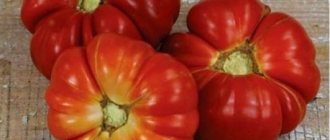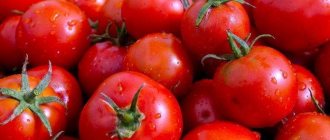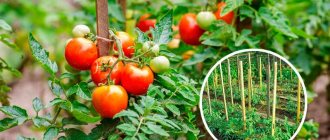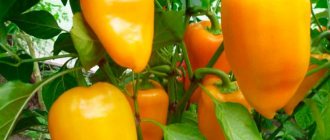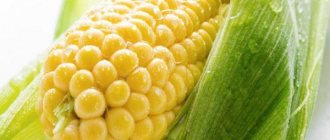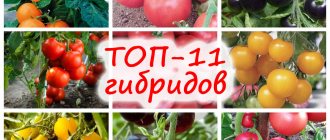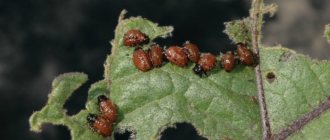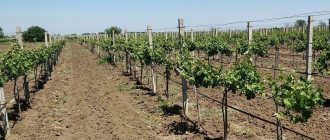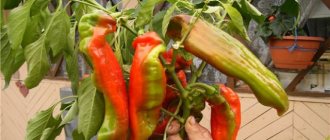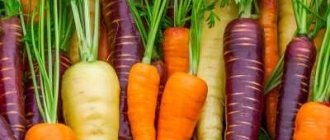The shelf life of tomatoes depends on many factors. This includes competent agricultural technology for growing plants throughout the season, and correct timely collection of fruits, and their subsequent sorting by size and degree of ripeness, and choice of location, and compliance with optimal conditions during storage (temperature, humidity, etc.).
And, of course, the initial choice of variety is very important - it’s no secret that different tomatoes differ markedly in this regard. For long-term storage, fleshy tomatoes with thick, smooth skin and medium-late and late ripening are better suited. Some of these tomatoes, if all storage conditions are met, can be kept fresh not only until the New Year, but almost all winter!
On the bushes of such tomatoes, only single fruits usually ripen (a special gene for “long ripening” is responsible for this). And before frost they are harvested unripe, green - the main part ripens during storage.
In many of these tomatoes, the “external” ripening, which many determine by the change in color to “ripe,” has nothing to do with the “internal” ripening. The seed chambers containing the contents of such tomatoes ripen much earlier than the fruit itself. Therefore, the seeds may well germinate directly in it.
The only serious disadvantage is that such tomatoes generally do not have a bright sweet taste, but rather have a rather average, “fresh” taste without an abundance of sugars and acids. However, as the proverb says, there is no friend according to taste. So, if you are interested in long-lasting tomatoes, pay attention to the following proven varieties.
Tomato New Year's
A variety of Russian selection, late ripening.
In the middle zone it is recommended for cultivation in greenhouses; in the southern regions it can be cultivated in open ground.
The plant is of medium size (above 1.5 m), indeterminate type, requires pinching and tying to a trellis. It is recommended to form this tomato into one stem.
The variety is unpretentious in cultivation, resistant to fusarium, tobacco mosaic, and cladosporiosis. Productivity – up to 3.5 kg per bush.
The fruits are flat-round in shape, medium in size (150-170 g), yellow-orange in color when fully ripe. Fruits should be collected and stored in a state of technical ripeness - green in color. The skin is smooth, dense, resistant to cracking, the flesh is pink, quite dense and juicy, crispy, of medium taste.
The fruits are well transported and have one of the longest shelf lives of similar varieties - up to March. Recommended for canning and processing.
Tomato Ozaltin red/yellow
The variety is high-yielding, late-ripening.
In the middle zone it is recommended for cultivation in greenhouses; in the southern regions it can be cultivated in open ground.
The plant is powerful, tall (above 1.8 m), indeterminate type, but not spreading, requires pinching and tying to a trellis. It is recommended to form this tomato into one or two stems.
The variety is unpretentious in cultivation and resistant to many diseases. Productivity – 4-5 kg per bush.
The fruits ripen in clusters, round-oval in shape, small and medium in size (60-110 g), leveled, red-orange in color when fully ripe (there is a yellow-fruited form of the variety). The skin is smooth, dense, the flesh is rich red, juicy, fleshy, with a good sweet and sour taste.
The fruits are easily transported and have a long shelf life. Recommended for fresh consumption, canning and processing.
Long-lasting, shelf-stable varieties of tomatoes
Long-lasting, shelf-stable varieties of tomatoes, which appeared not so long ago thanks to the efforts of domestic and foreign breeders, are becoming increasingly famous among gardeners. This is understandable. Almost everyone loves tomato salad, but in winter the prices for greenhouse products are steep, but here you can always get your own, home-grown ones from the box as much as you need and when you need it.
I have been growing similar varieties for several years now, and have tested a lot of them both for taste and shelf life. I have accumulated some experience, which I want to share with readers.
Retarded ripening
The fruits of these varieties can be stored fresh until January, February and even until the end of March (depending on the variety). The whole point is that these varieties have genes that inhibit the ripening of green fruits picked from the bush. The fruits left on the bushes ripen in the same way as those of ordinary varieties. Having removed the formed green fruits from the bushes, they are placed in 1-2 layers in boxes or small cardboard boxes and stored where the air temperature is only +15-18 degrees. Illumination does not play a role in this case.
They begin to ripen in 2-6 months (again, depending on the variety), but once fully ripe, they can remain for about a month without losing their marketable qualities.
Necessary prevention
But not everything is as simple as it might seem at first glance. In order to enjoy beautiful and tasty fruits in winter, seedlings must be treated with microelements or the preparations “Epin”, “Immunocytophyte”, “Silk” in early spring to increase their immunity to diseases. And during the growing season, also treat the plants with preparations against late blight at least three times. After all, in our country now you can hardly find an area where there would be no late blight pathogen that affects growing peppers, tomatoes and potatoes. Without such treatments, the fruits during long-term storage may rot before they have time to ripen, despite the fact that we picked them beautiful and clean.
Therefore, protecting long-lasting tomato varieties from diseases is a must.
Preference for varieties
There are now many mature varieties, and every year more and more of the same hybrids appear. So what should you choose? Hybrids are very resistant to diseases, but their seeds are too expensive, and you can’t collect your own seeds from them; you have to buy them again every year.
That's why I gave preference to varieties. Most varieties, when ripened, acquire an orange color on the outside of the fruit, and their flesh becomes pink-red. Here are the characteristics of some long-lasting varieties.
Medium-season tomato varieties - stored for up to two to three months
Japanese crab is a high-yielding variety, the fruits are shaped like a crab shell, become yellow when ripe, weighing up to 300-350 g.
Oak is a medium-sized bush, the fruits are red, round, very dense, grow in clusters, the variety is resistant to disease.
Lunar - bush up to 70 cm, fruits are elongated, very dense, weighing up to 100 g, red.
A new masterpiece - bushes up to 50 cm tall, with up to 12 fruits in a cluster, the fruits are round-elongated, thick-skinned, and last for more than three months.
Novorossiya is a high-yielding racemose variety, the fruits are spherical, weighing up to 300 g, the peel is slightly greenish, the flesh is red.
Keeping varieties of tomatoes - stored for more than four months
Rio Grande is a medium-sized bush, the fruits are elongated, grow 15-16 pieces in clusters, and ripen quite slowly.
Zhanina - bushes up to 50 cm high, the fruits are round with a spout, very hard to the touch (like stones), picked green, do not ripen for a long time. A very interesting promising variety.
Kirghiz late - a tall bush, the fruits are pink in color, round, growing in clusters of 6-7 pieces.
Podzimny - the fruits ripen on the bushes only by the end of November, picked green, they remain until Christmas, the fruits are heart-shaped, dense, weighing up to 350 g, red.
New Year's - grows in clusters of 12-16 pieces, the fruits are round with a spout, dense, yellow. They last well until the New Year.
Long-lasting tomato varieties - more than six months
Long-storing - the fruits are round, slightly elongated, weighing more than 300 g. The peel is yellowish-green, the flesh is pink, picked green, they are stored until March.
Vasilisa is a standard bush, up to 1 m high, the fruits are collected in a cluster of up to 10 pieces, weighing 60-80 g, they practically do not ripen on the bushes.
Giraffe - bushes up to 1.2 m high, fruits weighing more than 120 g, round, can ripen on bushes, red.
Long Keeper is a low bush, semi-spreading, the fruits are round, weighing up to 100 g, hard, rarely ripening on the bushes.
Orange ball - tall bushes, a raceme variety, high-yielding, the color of ripe fruits is yellow, the flesh is red, the fruits are spherical. Stores well until spring.
Before planting on the ridges, seedlings grow in the nest
I will share my experience of growing seedlings. My plant never gets sick after transplantation, because each plant grows in isolation from the others. To do this, I take a homemade long box and cut pieces of film along the width of the box, pour soil into them and lift the edge of the film. It turns out that each plant grows in its own nest.
When planting seedlings, I take the film by the edges, take it out of the box along with the soil, remove the film, and move the plants with a lump of earth and intact roots into holes in a garden bed or in a greenhouse or greenhouse.
narod-method.ru
Tomato Long Keeper
A variety of Soviet selection, high-yielding, late-ripening.
In the middle zone it is recommended for cultivation in greenhouses; in the southern regions it can be cultivated in open ground.
The plant is powerful, medium-sized (up to 1.4 m), determinate type, requires tying to a trellis, pinching is not necessary. It is recommended to form this tomato into one or two stems.
The variety is unpretentious in cultivation, resistant to fusarium, tobacco mosaic, and cladosporiosis. Productivity is about 6 kg per bush. The fruits, having reached full ripeness on the bush, may begin to crumble.
The fruits ripen in clusters, flat-round in shape, medium to large in size (150-300 g), and light pearl-orange in color when fully ripe. Fruits should be collected and stored in a state of technical ripeness - whitish-green in color. The skin is smooth, dense, the flesh is very dense, red-pink in color, good sweet taste with a slightly noticeable sourness.
The fruits are easily transported and have a very long shelf life - up to February-March. Recommended for fresh consumption, canning and processing.
Siberian Club of Country Life Lovers
The most shelf-stable varieties of tomatoes
- Like
- I do not like
Tyapochka February 26, 2018
LIST OF LEAST VARIETIES
The following hybrids have the “keeping quality gene”: Dominator F1, Radical F1, Akdeniz F1, Lazar F1, Dobrun F1, Albashi F1. Under natural conditions, they do not lose their qualities for 30-40 days, and in ideal conditions much longer.
Of the greenhouse varieties, the Red Stone variety is suitable for long-term storage. Dense, medium-sized tomatoes can be preserved until the New Year.
Hybrids Dekabrist F1 and Zazimok F1 live up to their name. The fruits do not fade during storage and remain firm. Decembrist has large fruits, up to 300 g, pink on the outside and red on the inside. The winter is a little smaller - up to 200 g.
Metelitsa F1 and Christmas Eve F1 are the “descendants” of the Decembrist, who took over from their parent the ability to be stored for a long time. Moreover, they can be salted in late autumn! Not in the summer, when there is a rush with the harvest, but in November.
One of the best varieties of Long Keeper is a large-fruited, pearl-pink variety, red inside. The fruits last until the New Year. Productivity up to 6 kg per bush.
Variety Masterpiece of Ukrainian selection. No matter how long it sits, the fruits never get a bright color, it remains yellow-orange, but the flesh inside is red - it’s clear that they are ripe.
A new masterpiece. The bushes are small - up to 50 cm, in one brush up to 10-12 pieces. The fruits are thick-walled and can be stored for more than three months.
Rio Grande. Very good variety. The bush is medium-sized, the shape of the fruits is elongated, there are up to 15 pieces in clusters. Stored perfectly.
Many people select the Khutorskaya variety, which can be stored for up to 4 months.
In addition to the varieties mentioned above, the fruits of hybrids are well stored in a cool place: Pharaoh, Tamerlane (more than 1 month), Intuition, Master (up to 1.5 months), Lazybok, Cartouche (can last until November). Volgogradsky-5/95 can last up to a hundred days.
Which of yours are the most durable?
Tomato Long-lasting
A variety of Russian selection, mid-late.
In the middle zone it is recommended for cultivation in greenhouses; in the southern regions it can be cultivated in open ground.
The plant is powerful, tall (above 1.5 m), semi-determinate type, requires pinching and tying to a trellis.
The variety is unpretentious in cultivation. Productivity – 4-5 kg per bush.
The fruits are flat-round, slightly ribbed, medium in size (90-150 g), and rich orange-yellow in color when fully ripe. Fruits should be collected and stored in a state of technical ripeness - green in color. The skin is smooth, dense, the pulp is very dense, orange-red in color, and has a satisfactory taste.
The fruits are easily transported and have a very long shelf life - up to February-March. Recommended for fresh consumption, canning and processing.
Features of cultivation and storage
Planted through seedlings or without seedlings. From 4 to 6 bushes are placed per 1 m2.
Seeds are sown 65-70 days before transplanting to stationary beds to increase yield.
Recommended tomato varieties
Mid-season / Mid-season
Taurus User rating: 4/5
Mid-season / Mid-season
Raspberry Rush User rating: 4/5
Early maturing / Medium growing
Moscow delicacy creamy f1 User rating: 4/5
Mid-season / Mid-season
French Bunch User Rating: 5/5
Tomato Snowfall F1
Hybrid of Russian selection, mid-season.
In the middle zone it is recommended for cultivation in greenhouses; in the southern regions it can be cultivated in open ground.
The plant is powerful, tall (up to 2 m), branched, indeterminate type, requires pinching and tying to a trellis. It is recommended to form this tomato into two stems.
The hybrid is unpretentious in cultivation, very cold-resistant, resistant to tobacco mosaic, and is slightly affected by anthracnose and alternaria. Characterized by an extended ripening period. Productivity – up to 4-4.5 kg per bush.
The fruits ripen in clusters, round-oval in shape, slightly ribbed towards the stalk, medium in size (100-130 g), leveled, light bright red in color when fully ripe. The skin is smooth, glossy, dense, does not crack, the flesh is aromatic, dense, red, of good taste.
The fruits are easily transported and have a long shelf life. Recommended for fresh consumption, canning and processing.
Tomato Giraffe
A variety of Russian selection, late ripening.
In the middle zone it is recommended for cultivation in greenhouses; in the southern regions it can be cultivated in open ground.
The plant is powerful, tall (above 2 m), semi-determinate type, requires pinching and tying to a trellis. It is recommended to form this tomato into one stem.
The variety is unpretentious in cultivation, resistant to brown spot, tobacco mosaic, and brown rot. Productivity – up to 3-4 kg per bush.
The fruits are round-oval, small to medium in size (60-130 g), light golden-orange in color when fully ripe. Fruits should be collected and stored in a state of technical ripeness - green in color. The skin is smooth, dense, the flesh is quite dense, with a small number of seeds, can be pink in color, and has an average taste.
The fruits are well transported and have one of the longest shelf lives of similar varieties - up to March. Recommended for canning and processing.
